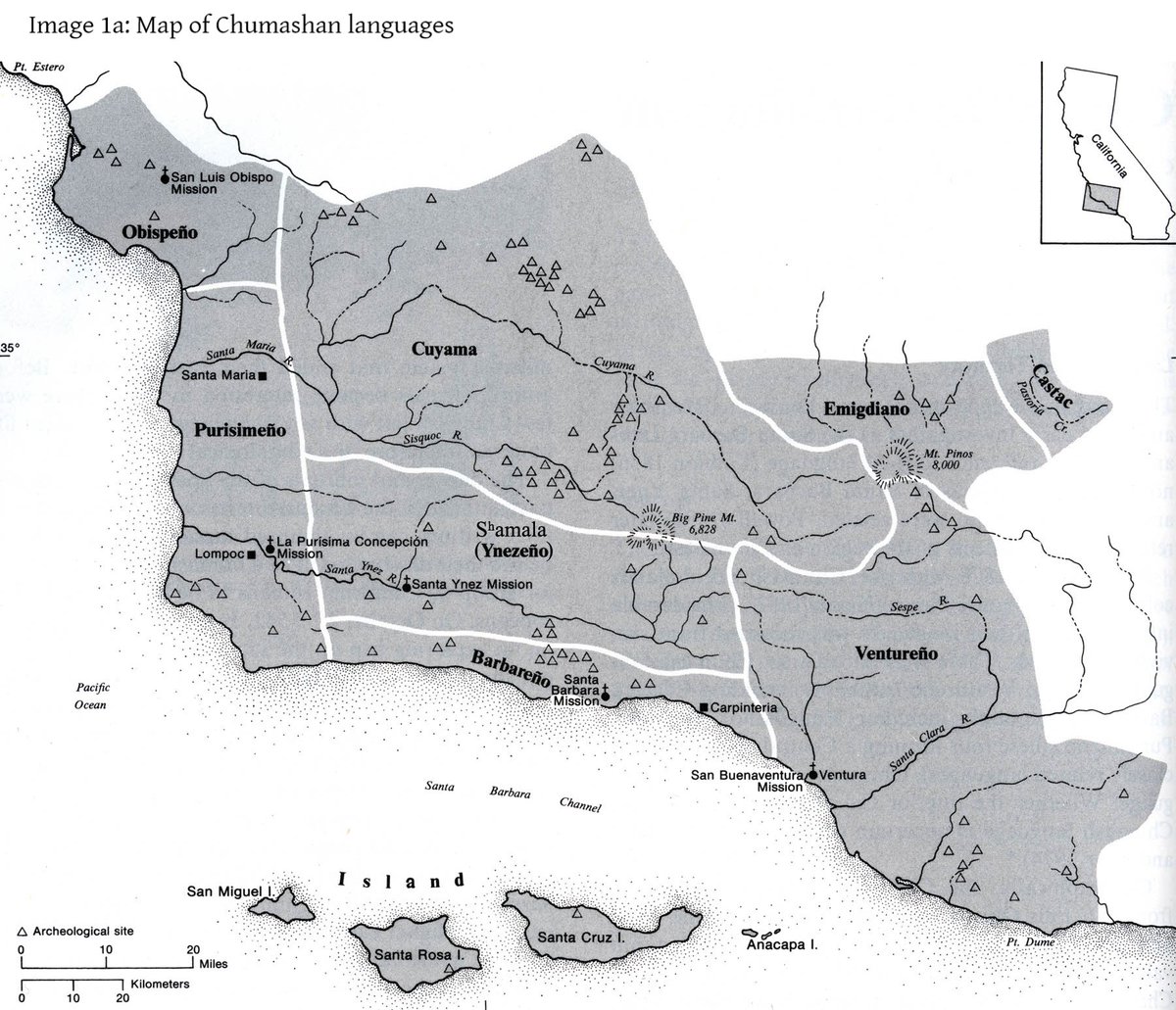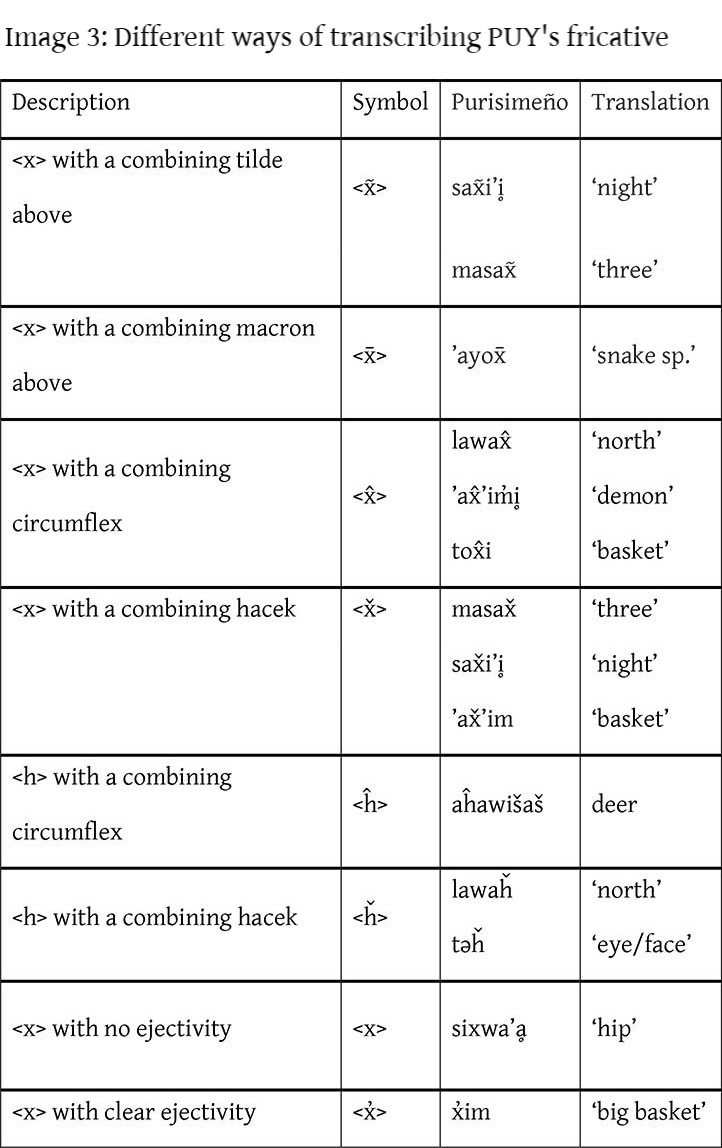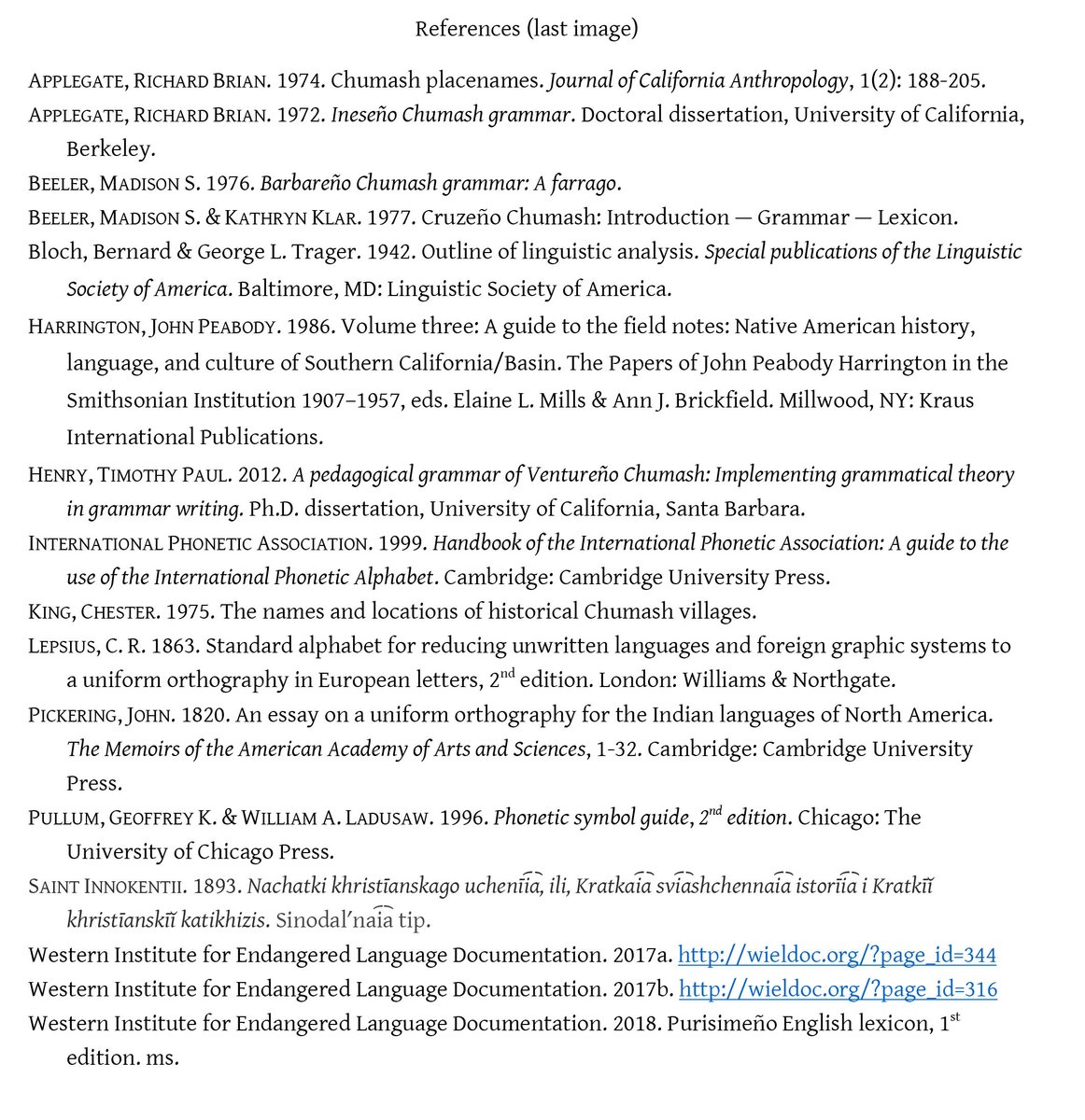1/12 “Fragmented languages: Reconstructing the Purisimeño fricative”
Purisimeño (PUY) is a Chumash language previously spoken along the central California coast. It was documented by John Peabody Harrington (JPH) in the early 1900’s. @wieldorg #FragmentedLanguageWorkshop2020
Purisimeño (PUY) is a Chumash language previously spoken along the central California coast. It was documented by John Peabody Harrington (JPH) in the early 1900’s. @wieldorg #FragmentedLanguageWorkshop2020
2/12 Other C. Chumash languages have 2 dorsal fricatives: <x> [χ] and <x̓> [χ̕ ]. PUY has the first, but it seems to have been in the process of changing location. In words where it occurs, it invariably corresponds to uvular fricatives or plosives in other C. Chumash languages.
3/12 Uvular place for the fricative seems to have been in the process of undergoing retraction. When produced with this alternate pronunciation, the sound is transcribed several ways: w/ an <x> or <h> and combining diacritic above: tilde, macron, circumflex, or hacek.
4/12 New place of articulation is written as <x̂> here. In JPH’s own description of the fricative: “[sound] is not [h] at all – deep reverberation.” “[it’s] very dry.” “x̂ is not very deep or wheezing – merely open.” (Note, /h/ is already a phoneme in the language.)
5/12 In the words of a native speaker: “[sound] was produced way down in the throat.” This rules out a palatal pronunciation, which JPH transcribes as <ç> anyway. Would also rule out a velar pronunciation, as this sound is further forward of the otherwise uvular production.
6/12 <x̂> does have application outside Chumashan lgs, although its use is rare. It’s possible JPH was inspired by the Aleut use of Cyrillic <χ̑> for [χ] (Saint Innokentii 1893). But note: 1) this is a weak connection at best, 2) the sound in PUY would already have been uvular, &
7/12 3) Surely, Harrington with his keen ear and vast experience with other languages of California could clearly articulate the distinction in place of articulation between a velar and uvular fricative.
8/12 It is proposed that the mystery fricative in PUY was a voiceless pharyngeal fricative [ħ], and that, at the time of recording, a sound change in progress was being documented. There is a strong preference for <x̂> over <x̣> thoough no conditioning of <x̂> is apparent.
9/12 Indirect support for the pharyngeal hypothesis. The ejective fricative <x̣> [χ̕ ], though rare per word in C. Chumash, is in common words, like the word for ‘big,’ ‘woman,’ and ‘basket.’ Examples of this phoneme have been given in Image 4.
10/12 What would be an ejective uvular fricative reflex is absent in all but one word in the available PUY data, however: <x̂’im̓i̥> ‘small mouthed basket.’ The phone [ħʼ] is an impossible segment, of course, and this is no doubt why PUY no longer clearly has a <x̣> phoneme.
11/12 It is proposed instead that, in a limited number of circumstances (perhaps only 1), <x̣> has, in PUY, changed to a sequence [ħʔ] where [ħ] is either a coda in a preceding syllable as in <’ax̂’im̓i̥> [ʔaħʔim̓i̥] ‘(a) small mouthed basket’ or [ħ] may be simply presyllabic.

 Read on Twitter
Read on Twitter

![2/12 Other C. Chumash languages have 2 dorsal fricatives: <x> [χ] and <x̓> [χ̕ ]. PUY has the first, but it seems to have been in the process of changing location. In words where it occurs, it invariably corresponds to uvular fricatives or plosives in other C. Chumash languages. 2/12 Other C. Chumash languages have 2 dorsal fricatives: <x> [χ] and <x̓> [χ̕ ]. PUY has the first, but it seems to have been in the process of changing location. In words where it occurs, it invariably corresponds to uvular fricatives or plosives in other C. Chumash languages.](https://pbs.twimg.com/media/EpDXT-yU0AA9l5m.jpg)
![2/12 Other C. Chumash languages have 2 dorsal fricatives: <x> [χ] and <x̓> [χ̕ ]. PUY has the first, but it seems to have been in the process of changing location. In words where it occurs, it invariably corresponds to uvular fricatives or plosives in other C. Chumash languages. 2/12 Other C. Chumash languages have 2 dorsal fricatives: <x> [χ] and <x̓> [χ̕ ]. PUY has the first, but it seems to have been in the process of changing location. In words where it occurs, it invariably corresponds to uvular fricatives or plosives in other C. Chumash languages.](https://pbs.twimg.com/media/EpDXvx5U8AAqCAX.jpg)

![9/12 Indirect support for the pharyngeal hypothesis. The ejective fricative <x̣> [χ̕ ], though rare per word in C. Chumash, is in common words, like the word for ‘big,’ ‘woman,’ and ‘basket.’ Examples of this phoneme have been given in Image 4. 9/12 Indirect support for the pharyngeal hypothesis. The ejective fricative <x̣> [χ̕ ], though rare per word in C. Chumash, is in common words, like the word for ‘big,’ ‘woman,’ and ‘basket.’ Examples of this phoneme have been given in Image 4.](https://pbs.twimg.com/media/EpDaf_4U8AIzo-U.jpg)
![11/12 It is proposed instead that, in a limited number of circumstances (perhaps only 1), <x̣> has, in PUY, changed to a sequence [ħʔ] where [ħ] is either a coda in a preceding syllable as in <’ax̂’im̓i̥> [ʔaħʔim̓i̥] ‘(a) small mouthed basket’ or [ħ] may be simply presyllabic. 11/12 It is proposed instead that, in a limited number of circumstances (perhaps only 1), <x̣> has, in PUY, changed to a sequence [ħʔ] where [ħ] is either a coda in a preceding syllable as in <’ax̂’im̓i̥> [ʔaħʔim̓i̥] ‘(a) small mouthed basket’ or [ħ] may be simply presyllabic.](https://pbs.twimg.com/media/EpDbAyHVoAEyChg.jpg)



